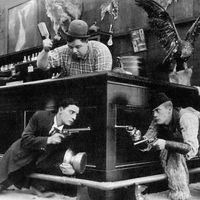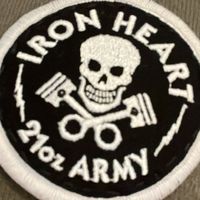IRON CAST by Iron Heart International
-
Really really informative @Giles… I can't think of another brand that allows such a personal insight to the history and ethos of the company, and along with the forum... actually allows your customers to be 'part' of the the IH journey
Only really discovered IH in 2018 - I cant for the life of me think why it took so long to do so!
-
…wonderful interview Giles!

...thinking you guy's should pump out another round of YouTube videos too! When I was first introduced to Iron Heart the videos were fun to watch!

...on that note I'm going over to buy a shirt!
 IHSH-33B pimped with copper snaps!
IHSH-33B pimped with copper snaps!...Cheer's to Iron Heart!

-
As a podcast junkie I am so delighted that this came out! Great listen and I agree that a denim polo would be outstanding!

Looking forward to Alex in the next round!
-
My French friends call me (to my face anyway
 :)) Jeel…..(the J sounding like the Zh of Zhivago)
:)) Jeel…..(the J sounding like the Zh of Zhivago)those are good friends…

Oh and the podcast is awesome, great interview with a casual feel. Super stoked this is happening and excited for the upcoming episodes!
Cheers
-
This was great to listen to. Another comment to follow.

-
When @Giles mentioned that there were places that you couldn't / shouldn't wear jeans into reminded me of when I was in Rome 2018,and I walked into this place where Frank Sinatra had eaten at many years ago. I noticed a bunch of noses twitching when I walked in, but my thought was I had spent more on the Iron Heart I was wearing than what the nose twitchers, were wearing.
-
Good point @ROman –- an entire kit, head to toe( toe being Wesco`s or something similar)
would be between 1,000-1,500 easily I would think:
When I was in Rome I did notice that they people do have a good sense of fashion, but that they were also kind of fashion snobs at the same time. -
The podcast was a perfect duration for 25 miles on the bike. Lots of interesting stuff, having seen very good artists at work I can understand his exacting sense of control. That’s what makes the stuff what it is after all. Also interested then in the future of the designs when H wants to step away. Will be interesting at that point to see how the brand identity evolves. Looking forward to next episode.
-
Interesting Podcast.
Giles commenting on the Forum particularly intrigued me,as a place where likeminded people who like GOOD things can congregate(sorry I forget the exact wording).
It’s a question that remains unanswered for me,and I have put to many friends/designers/artists over the years.
What is GOOD taste?
I get the form+function of good design,but is good taste only what an individual finds personally tasteful and not embraced bye the masses? -
Subscribed and Reviewed.

-
Interesting Podcast.
Giles commenting on the Forum particularly intrigued me,as a place where likeminded people who like GOOD things can congregate(sorry I forget the exact wording).
It’s a question that remains unanswered for me,and I have put to many friends/designers/artists over the years.
What is GOOD taste?
I get the form+function of good design,but is good taste only what an individual finds personally tasteful and not embraced bye the masses?Can't say as to good taste but I know bad when I see it.
-
Just listened to Giles on the podcast, also a first podcast for me. I live in Japan and am still struggling with Japanese culture after 20 years! So it was good to hear about Giles struggles too. And laugh at those funny stories. But they are so true! I am trying to upload some images of our visit to Gosport, but it doesn't seem to work from my Mac. Any suggestions?
-
Listened to this and really enjoyed it. Here are two things I found most thought provoking:
First, I'm currently in an engineering management masters program, and I'm actually taking a course in global virtual teams right now. Cultural considerations are a huge potential stumbling block in multi-national teams, as I'm sure many can imagine. I liked how the podcast highlighted just how special the Iron Heart model is, and how it was a rare partnership formed partially by luck, and partially by the unique characters involved. There were probably 1000 ways that it wouldn't have worked, and only one way it could have.
Second, jeans people (and people who appreciate quality), definitely feel that their stuff has it's own life and story. And there's a sense that your possession of it, though consequential, is not the beginning of the story for that thing. I think that's why people are drawn to Gosport, and why people devour any access to the other manufacturers of their cherished stuff. They go on distillery tours of their favorite bourbon or factory visits of cigars. Quality stuff takes people caring about it being quality, from start to finish.
I think that last bit has been placed in stark relief by the Suez canal fiasco. Just how much crap needs to be shipped all over the place. There really are two different models of "global commerce" working at the same time. One that uses "global connectedness" to bring together people who can add the most value, and another that uses it to race to the bottom. I think this article in The Atlantic nailed it.
Global shipping is an unglamorous business that has created some extremely glamorous fortunes, but mostly for people you’ve never heard of (unless you’re an art dealer). If you never, ever think about all the big-ass boats out there full of cheap clothes or baby strollers, the industry is working as designed. But a significant majority of your material possessions, including virtually everything you’ve ever bought from Amazon or Best Buy or Target or Walmart, was ferried most of the way from where it was manufactured to where you bought it on a ship similar to the one currently taking an extended smoke break in the Suez.
…
When people have to think about that—and perhaps, as a result, feel connected to the high-stakes logistical ballet that is global manufacturing, or implicated in the often miserable working conditions of the faraway people who make it possible—something consumer psychologists call “friction” is introduced into the buying process. Retailers, manufacturers, and shippers alike benefit if purchase decisions feel unencumbered by anything but consumers’ personal desire, which means the origins of the things we buy are usually obscured.
I think I'm like many here that nothing feels better than pulling the trigger on a $300 shirt or a $700 pair of boots, because we know where these things came from, often from raw material to our door. For us, knowing more reduces friction, not the other way around. So, I hope the IH model is the real future of global commerce: less stuff, better made, where the more you learn the better it sounds.
-
I think I'm like many here that nothing feels better than pulling the trigger on a $300 shirt or a $700 pair of boots, because we know where these things came from, often from raw material to our door. For us, knowing more reduces friction, not the other way around. So, I hope the IH model is the real future of global commerce: less stuff, better made, where the more you learn the better it sounds.
Great post. I agree 100% with your conclusion. That "good friction" is all over an IH product, as evidenced by this this forum and our common interest in the how's and why's of nearly every aspect of provenance, design and construction.
-
Hi Giles, I clicked "upload images" and selected some pictures, but all that came out was a load of letters and numbers. So any more advice you have would be appreciated.






